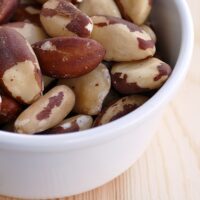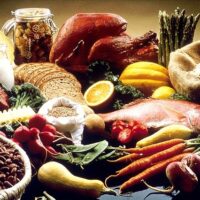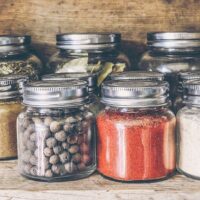4 Brazil Nuts a Month to Help Lower LDL
Sounds crazy, right? I recently read about a small study done in Brazil (of course), to see if Brazil nuts helped lower LDL.
LDL is the “bad” cholesterol that you want to be lower. HDL is the “good” cholesterol that you want to be higher.
Turns out that 4 Brazil nuts eaten only once a month in a single serving, almost immediately lowers LDL cholesterol.
In the study, LDL levels dropped twenty points just nine hours after eating the nuts. And stayed down for a month.
That’s a big deal.
Now, I’m not suggesting that you discontinue your present regimen to lower cholesterol if you’re being treated for high cholesterol.
I am sharing the results of this study because, unless you’re allergic to Brazil nuts, eating 4 of them in one sitting once a month is probably not going to cause you harm.
This regimen is cheap, easy, healthy.
Why do the researchers think this works?
Selenium, a trace mineral, could be part of the answer.
For adults ages 19 and over, the recommended daily amount of selenium is 55 micrograms (mcg). A single Brazil nut contains about 68–91 mcg.
While we need selenium, a little goes a long way, which is why only 4 Brazil nuts per month is the magic number. Too much can cause harm.
Selenium has anti-inflammatory and antioxidant properties, supports thyroid and cognitive function, helps prevent plaque build-up in arteries, helps prevent cancer, especially prostate cancer.
Supplementation is typically not necessary since most of us get our daily requirement of selenium from whole foods like salmon, chicken, mushrooms, eggs, oats, sunflower seeds, turkey, chicken, navy beans.
What else can you do to help lower LDL?
- Avoid smoking.
- Consume soluble fiber: Sources include oats, beans, lentils, fruits (like apples and pears), and vegetables (like Brussels sprouts and broccoli).
- Reduce refined sugars and processed carbohydrates.
- Consume omega-3 fatty acids: Fatty fish like salmon, mackerel, and sardines are great sources.
- If you drink alcohol, do so in moderation. For healthy adults, that means up to one drink a day for women and up to two drinks a day for men.
- Regular exercise can raise HDL cholesterol (the “good” cholesterol) while lowering LDL cholesterol. Aim for at least 30 minutes of moderate-intensity aerobic activity most days of the week.
- Losing excess weight can lower LDL, especially if weight loss is combined with increased physical activity and dietary changes.
- Reduce saturated and trans fats: These are found in fried foods, cakes, pies, certain margarines and other processed foods.
- Eat monounsaturated fats like avocados and extra virgin olive oil.
- Reduce saturated fat: Limit the intake of foods high in saturated fats, such as red meat, full-fat dairy products, and fried foods.
(Remember, it’s essential to consult with a healthcare provider before making significant changes to your diet or lifestyle, especially if you have underlying health conditions or are on medication.) 
If you’re struggling to lower your LDL and feel overwhelmed, let’s talk. I’m here to help you figure out a plan that is sustainable, even during the holidays.
And yes, Mr. Non-Compliant eats 4 Brazil nuts each month—and ONE donut.
If you have trouble finding Brazil nuts, check out vitacost.com or nuts.com. Store them in the fridge or freezer so that they stay fresh over time.
Much love,
Health Coach Carol
“Eat food. Not too much. Mostly plants.”― Michael Pollan








